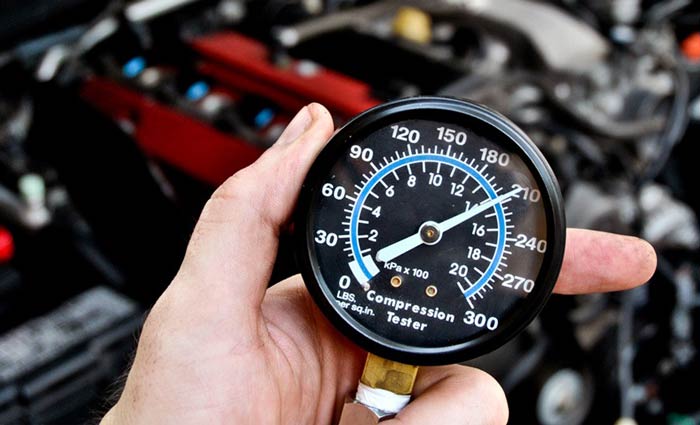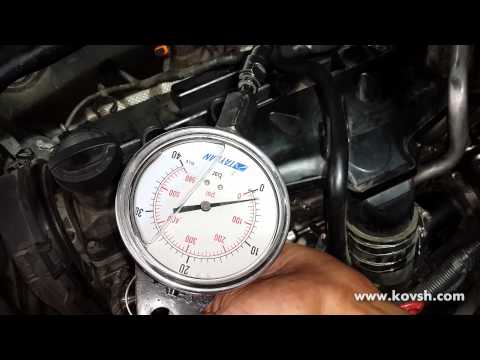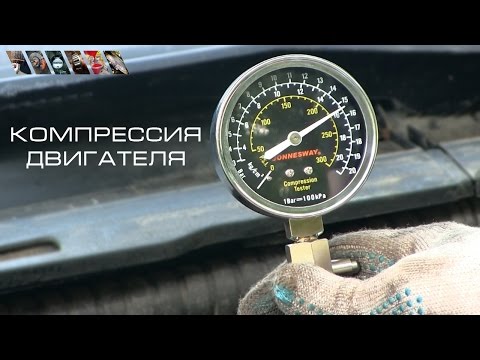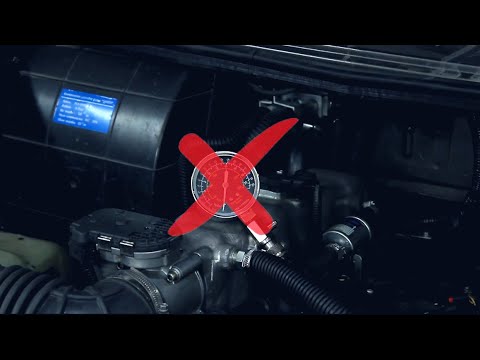
ICE compression check
Content
An internal combustion engine compression test is performed to troubleshoot internal combustion engines. Compression is the compression of the mixture in the cylinder under the influence of external forces. It is measured as the compression ratio multiplied by 1,3. When measuring compression, you can find the cylinder that is malfunctioning.
If the car has various kinds of problems, such as a drop in power, loss of oil, tripping in the engine, then they check the candles, sensors, inspect the internal combustion engine for damage and leaks. When such checks do not bring results, then they resort to measuring compression. How to determine it using the example of the VAZ classic is shown in this video.
Independently Compression can be checked with a compression gauge.. At service stations, such checks are made using a compressograph or a motor tester.
The reasons for the decrease in compression in the cylinders
ICE compression can decline for many reasons.:
- wear of pistons and parts of the piston group;
- incorrect timing setting;
- burnout of valves and pistons.
in order to specifically determine the cause of the breakdown, the internal combustion engine compression is measured both hot and cold. We will figure out how to carry out such a procedure both with the help of a compression gauge and without it.
How to measure compression in an internal combustion engine
First you need to prepare the internal combustion engine for testing. To do this, we need to warm up the internal combustion engine to a high temperature of 70-90 degrees. After that, you need to turn off the fuel pump, so that fuel is not supplied and unscrew the spark plugs.
After all this Let's move on to the compression test.:
- We insert the tip of the compression gauge into the spark plug connector and turn the engine with the starter until the pressure growth stops.
- The crankshaft should rotate at about 200 rpm.
- If the ICE is correct, then compression should rise in seconds. If this happens for a long time, the piston rings burn out on the face. If the pressure does not increase at all, then most likely the block gasket needs to be changed. The minimum pressure in a gasoline internal combustion engine should be from 10 kg/cm20 (in a diesel internal combustion engine more than XNUMX kg/cmXNUMX).
- After taking readings, release the pressure by unscrewing the cap on the meter.
- Check all other cylinders in the same way.
Illustration of the stages of measuring compression in the cylinder
There is another way to check, which differs from the above in that oil is poured into the checked cylinder. An increase in pressure indicates worn piston rings, if the pressure does not increase, then Cause: cylinder head gasket, or in general there is a leak in the valves.
You can also diagnose weak compression by malfunctions in the carburetor. In case of air leakage, check the fit of the bypass valve. If air is escaping through the top of the radiator, then the faulty cylinder head is to blame.
What affects ICE compression
- Throttle position. When the throttle is closed or covered, the pressure decreases
- Dirty air filter.
- Wrong order of valve timingwhen the valve closes and opens at the wrong time. This happens when the belt or chain is incorrectly installed.
- Closing valves at the wrong time due to gaps in their drive.
- Motor temperature. The higher its temperature, the higher the temperature of the mixture. Therefore, the pressure is lower.
- Air leaks. Air leaks, reduce compression. They are caused by damage or natural wear of the combustion chamber seals.
- Ingress of oil into the combustion chamber increases compression.
- If the fuel falls in the form of droplets, then the compression decreases - the oil is washed off, which plays the role of a sealant.
- Lack of tightness in the compression gauge or in the check valve.
- crankshaft speed. The higher it is, the higher the compression, there will be no leaks due to depressurization.
The above describes how to measure compression in an internal combustion engine running on gasoline. In the case of a diesel engine, measurements are made differently.
Compression measurement in a diesel engine
- In order to turn off the diesel supply to the engine, you need to disconnect the fuel supply valve from the power supply. it can also be done by clamping the shut-off lever on the high pressure pump.
- Measurements on a diesel engine are made by a special compression gauge, which has its own characteristics.
- When checking, you do not need to press the gas pedal, since there is no throttle in such internal combustion engines. If it is, it must be cleaned before checking.
- any type of internal combustion engine is equipped with special instructions on how compression is measured on it.

Compression test on a diesel engine.

Compression test on an injection car
It is worth remembering that compression measurements can be inaccurate. When measuring, for the most part, you need to take into account the pressure difference in the cylinders, and not the average compression value.
Be sure to take into account such parameters as the temperature of the oil, internal combustion engine, air, engine speed, etc. Only taking into account all parameters it is possible to draw a conclusion about the degree of wear of pistons and other parts that affect compression. And as a result of all these malfunctions, give a conclusion about the need for a major overhaul of the internal combustion engine.
How to check compression without a compression gauge
You won't be able to measure compression without a gauge. Since the very word "measurement" implies the use of a measuring instrument. So that it is impossible to measure compression in an internal combustion engine without a compression gauge. But if you want to check determine if it exists (for example, after a broken timing belt or a long car downtime, etc.), that is, some of the easiest ways How to check compression without a compression gauge. A sign of poor compression is the atypical behavior of a car, when, for example, at low speeds it works sluggishly and unstable, and at high speeds it “wakes up”, while their exhaust smoke is bluish, and if you look at the candles, they will be in oil. With a decrease in compression, the pressure of crankcase gases increases, the ventilation system becomes dirty faster and, as a result, an increase in CO toxicity, pollution of the combustion chamber.
Compression test without instruments
The most elementary ICE compression test without instruments - aurally. So, as usual, if there is compression in the internal combustion engine cylinders, then by turning the starter you can hear how the engine works out any compression stroke with a characteristic sound. And in most cases, the internal combustion engine can wiggle a little. When there is no compression, no clear beats will be heard, and there will be no trembling. This behavior often indicates a broken timing belt.

Video how to check the compression of an internal combustion engine without instruments
Stoppered suitable diameter (rubber, cortical plastic or thick cloth) candle well, having previously unscrewed the candle of one of the cylinders, you can check if there is at least some kind of compression. After all, if it is there, then the cork will fly out with a characteristic cotton. If there is no compression, then it will remain where it was.
The applied force when turning the KV. This method of checking compression does not have any accuracy at all, but, nevertheless, people sometimes use it. It is necessary to unscrew all the candles, except for the first cylinder and by hand, by the crankshaft pulley bolt, rotates until the compression stroke ends (determined by the timing marks). then we repeat the same procedure with all the other cylinders, approximately remembering the applied force. Since the measurements are rather arbitrary, it is therefore preferable to use a compression gauge. Such a device should be available to every car owner, because its price is so high in order not to buy, and his help may be needed at any time. you can find out the desired compression value for your car from the service manual or at least find out the compression ratio of the internal combustion engine of your car, then the compression can be calculated by the formula: compression ratio * K (where K \u1,3d 1,3 for gasoline and 1,7-XNUMX, XNUMX for diesel internal combustion engines).
According to the state of the exhaust or the condition of the spark plugs, only an experienced minder can determine compression without a device, and that is the same, relatively.
This method relevant for cars with a worn enginewhen topping up became more frequent, and a white-blue smoke with a specific smell appeared from the muffler. This will indicate that the oil began to enter the combustion chambers in several ways. A competent minder in terms of exhaust and the condition of candles, as well as analyzing acoustic noise (to listen to noise, you need a device that is a medical stethoscope with a mechanical sensor), will accurately determine why such smoke and oil consumption.
There are two main culprits for the presence of oil - oil reflective valve caps or a cylinder-piston group (rings, pistons, cylinders), which indicates deviations in compression.
When the seals are worn out, they often appear oil rings around spark plugs and exhaust, then and Compression test may or may not be done.. But if, after warming up the internal combustion engine, the characteristic smoke continues or its intensity increases, it can be concluded that the internal combustion engine is worn out. And in order to determine what exactly caused the compression to disappear, you need to perform a few simple tests.
Missing Compression Tests
in order to get an accurate answer, it is required to use all of the above methods with a comparison of the results obtained.
To determine the wear of the rings, it is enough to spray, from a syringe, literally 10 grams of oil into the cylinder, and repeat the check. If the compression has increased, then the rings or other parts of the cylinder-piston group are tired. If the indicators remain unchanged, air leaks through the gasket or valves, and in rare cases due to a crack in the cylinder head. And if the pressure has changed literally by 1-2 bar, it's time to sound the alarm - this is a symptom of piston burnout.
Compression measurement results
Compression measurement results show the condition of the internal combustion engine, namely pistons, piston rings, valves, camshafts, and allow decisions to be made on the need for repair or only replacement of the head gasket or valve stem seals.
On gasoline engines, normal compression is in the range of 12-15 bar. If you understand in more detail, the trend will be as follows:
- front-wheel drive domestic cars and old foreign cars - 13,5-14 bar;
- rear-wheel drive carburetor - up to 11-12;
- new foreign cars 13,7-16 bar, and turbocharged cars with a large volume up to 18 bar.
- in the cylinders of a diesel car, the compression should be at least 25-40 atm.
The table below shows more accurate compression pressure values for different ICEs:
| ICE type | Value, bar | Wear limit, bar |
|---|---|---|
| 1.6, 2.0 l | 10,0 - 13,0 | 7,0 |
| 1.8 l | 9,0 - 14,0 | 7,5 |
| 3.0, 4.2 l | 10,0 - 14,0 | 9,0 |
| 1.9 L TDI | 25,0 - 31,0 | 19,0 |
| 2.5 L TDI | 24,0 - 33,0 | 24,0 |
Results of growth dynamics
When pressure value 2–3 kgf/cm², and then, in the process of turning, rises sharply, then most likely worn out compression rings. In the same case, the compression increases sharply on the first cycle of operation, if oil is dropped into the cylinder.
When pressure immediately reaches 6–9 kgf / cm² and then practically does not change, it is most likely that valves not tight (lapping will fix the situation) or worn cylinder head gasket.
In the case where it is observed compression reduction (about on 20%) in one of the cylinders, and at the same time the engine idling is unstable, then a large probability of wear of the camshaft cam.
If the results of measuring compression showed that in one of the cylinders (or two adjacent ones), the pressure rises noticeably more slowly and at 3-5 atm. below normalthen Probably a blown gasket between the block and the head (you need to pay attention to the oil in the coolant).
By the way, you should not rejoice if you have an old internal combustion engine, but compression has increased than on a new one - the increase in compression is due to the fact that as a result of long work combustion chamber has oil deposits which not only impair heat dissipation, but also reduce its volume, and as a result, detonation of glow ignition and similar problems appear.
Uneven cylinder compression causes vibration of the internal combustion engine (especially noticeable at idle and low speeds), which in turn also harms both the transmission and the engine mount. So, having measured the compression pressure, it is imperative to draw conclusions and eliminate the defect.